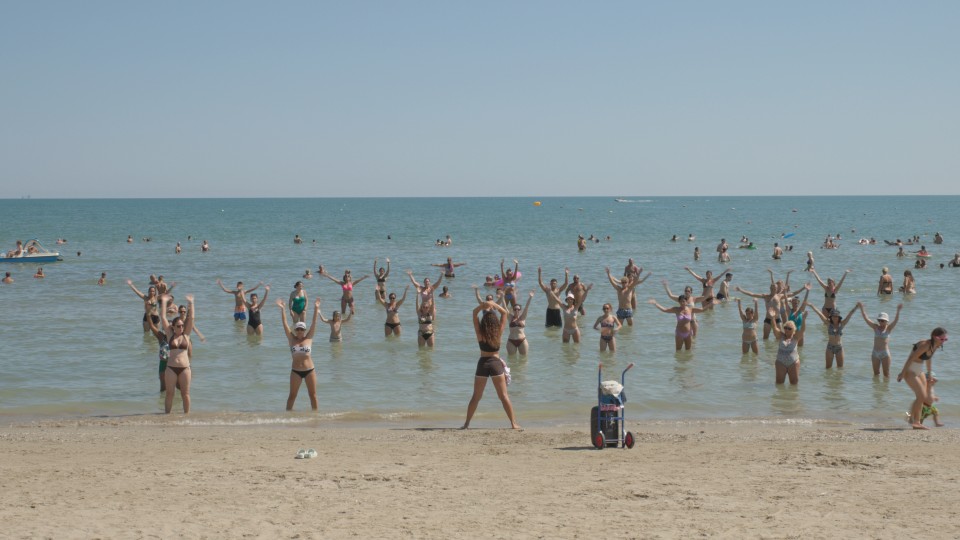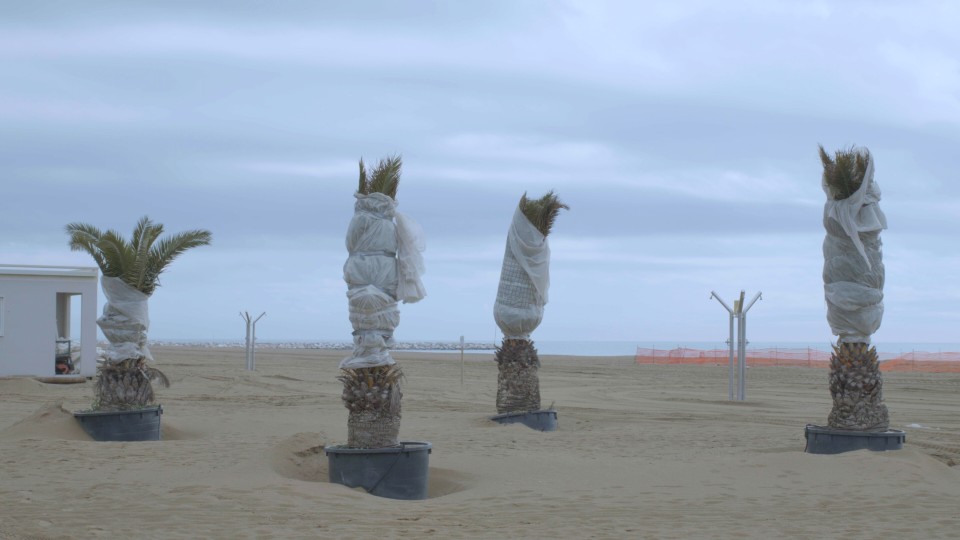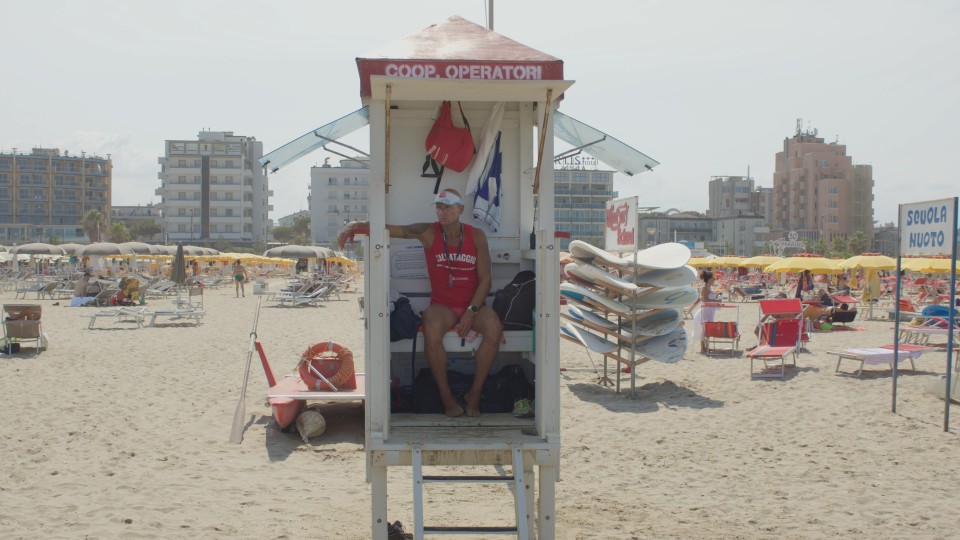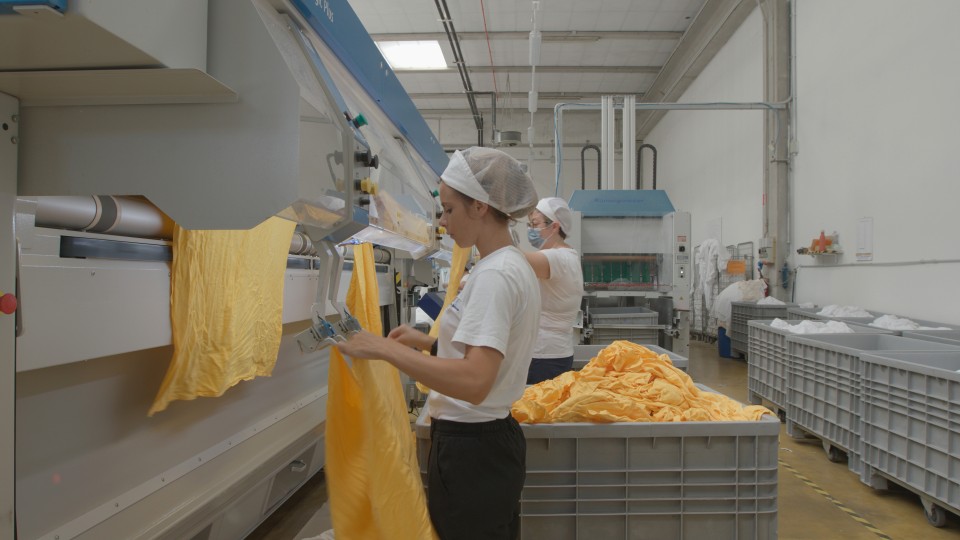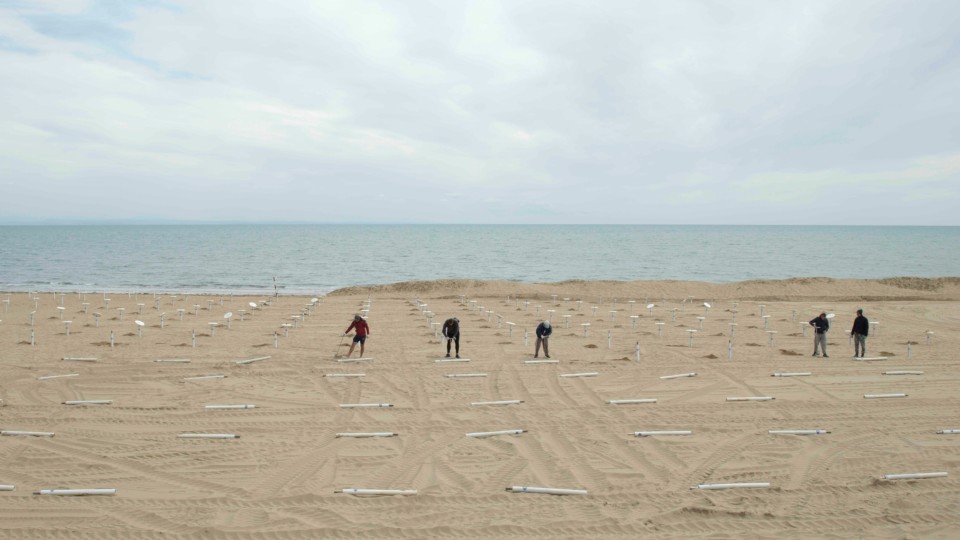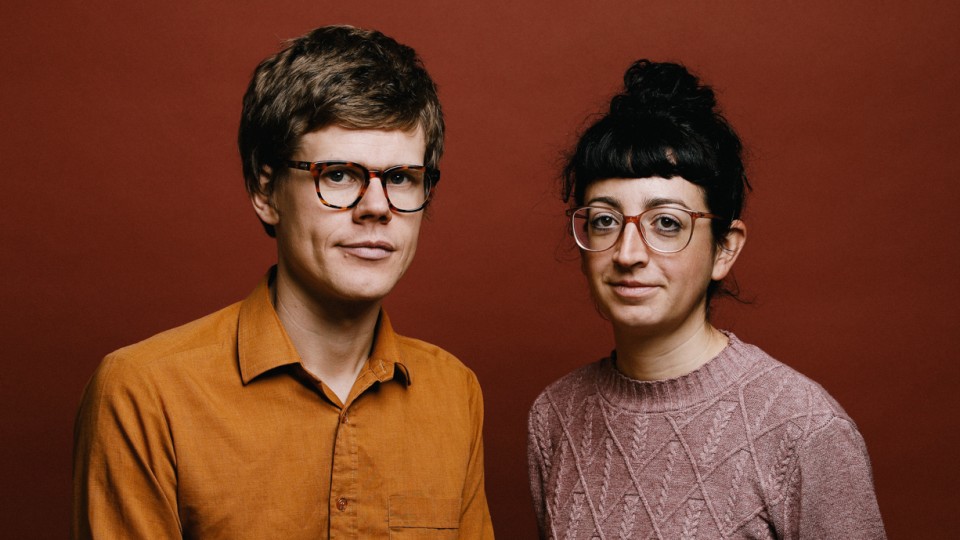A view of the sea represents a longing – often to recuperate from a whole year of hard work and everyday stress. To provide
some people with this brief break on the beach in the sun, others have to work hard all summer. In VISTA MARE, Julia Gutweniger and Florian Kofler have created an essay on visible relaxation and invisible activity, focusing on the landscape
of Adriatic tourism, which is operated at full throttle for a few summer weeks every year without much regard for resources.
Landscape always seems to comprise an interesting field of tension in your works. VISTA MARE focuses on a geographical and
climatic situation which is exploited seasonally for an extremely short period; the landscape itself is completely buried
under infrastructure.
FLORIAN KOFLER: Landscape is a central theme in our first documentary, Security123, and also in VISTA MARE. In both films, it has a very artificial, unexpected aspect – contrary to what might be expected.
JULIA GUTWENIGER: The entire landscape is constructed, and our characters, the people we accompany in the film, are very much part of this landscape.
They are the ones who shape it, turn it into a holiday resort, and then never have time to go swimming there themselves, throughout
the entire season – because they have to work.
FLORIAN KOFLER: "Vista Mare" – a sea view – is a crucial requisite for the landscape we examine in this film. What happens two streets further
back is deemed to be of no interest to the tourists who spend their hard-earned vacations here. The resort is actually a non-place.
It is a function of the sea – and the ideal view on holiday is across the sea.
One shot in VISTA MARE that sums up your cinematic approach shows the panels of a façade which provide the illusion that people
are moving in a boat through a canal in Venice
and then you cut to what is behind them. Were you interested in studying the
tension between oppositions: the façade and what is behind it, the immensely hard work of some, which makes the inactivity
of others an experience?
JULIA GUTWENIGER: It was precisely these parallel worlds that aroused our interest. Some people are on holiday, and all the time others are
working – with a sea view. Our approach is literally to go behind the scenes of the holiday world, to the people working there.
FLORIAN KOFLER: These binary places have preoccupied us for a long time. If you visit them in February, they have virtually shut down. In
terms of appearance they are like ruins, reminiscent of post-apocalyptic scenarios, but when the season starts again they
come alive in a big way and really pulsate with activity. The places where we filmed have the charm of the tourism wave in
the post-war years, when the German economic miracle brought a lot of prosperity to Italy. You can still see from the architecture
that tourism reached its peak at a specific time. It looks outmoded but also has a hybrid quality, because it’s constantly
growing and being modified. And all the time the concept behind it, the system, remains unchanged.
Where did you film?
JULIA GUTWENIGER: We shot in the strongholds of Italian summer tourism, between Lignano and Riccione.
FLORIAN KOFLER: It's a strip of coastline about 300 km long. We looked at the Italian tourism statistics. At the top there’s
Rome, Venice, Milan
and then come Cavallino Treporti and San Michele al Tagliamento, and you ask yourself – what are these
places? How is that possible? They’re the places at the heart of Adriatic tourism. Villages or small towns with a few thousand
residents but millions of holidaymakers.
How were you able to position yourself with your camera during this holiday season?
FLORIAN KOFLER: From the very beginning, it was important to us that the camera should find a calm and somehow precise stance that wouldn’t
be disrupted by the hustle and bustle of the holidays. So we specifically looked for people, activities and processes that
are otherwise not given special attention but which reveal much more cinematically than you might think.
JULIA GUTWENIGER: But even from a purely physical point of view, positioning the camera in the holiday scene is a bit of a challenge, with those
crowds. We often had to make sure that the tourists, dazed with sunstroke, didn’t wander into the shot. Since there are always
only two of us on set, while we were filming we sometimes had to shepherd the crowds along, behind the camera, like school
crossing guards.
In addition to raising the issue of working conditions, VISTA MARE also poses the question of how people reward themselves
for a year of work? What is a vacation?
JULIA GUTWENIGER: ... or the question: what is work? After all, we not only build our own landscapes but often our own systems, too.
There is a scene in the film showing a demo, which is very surprising in the context of the resort. At what point in the season
did that take place? What were the reactions to it?
FLORIAN KOFLER: The demo took place during the high season, in August. The trade unions there are very small. Generally, they hold demos
before the season starts, so people have the benefit of any concessions when they sign their contracts. The demonstrations
are very closely monitored. You see maybe 150 demonstrators, and the police presence is about as strong. The trade unions
don’t have an easy job; for years they’ve been formulating the demands they are fighting for, and at the same time you sense
that the situation has deteriorated, if anything. The visitors ignore the issues here, don’t notice the demos or just look
away with disparaging expressions.
JULIA GUTWENIGER: It’s definitely the case that a few people make a lot of money from tourism, while others work day and night just to get by.
You can see it; the person who serves cocktails late at night is often the same person who makes coffee in the morning.
FLORIAN KOFLER: We made a conscious decision to show those people. We didn’t use the camera to show that everything’s rosy; we always went
to places where tourism is backbreaking work. For us, the big challenge in terms of montage was to get this ambiguity right,
to show that the whole thing isn’t just beautiful or just bad. It's like a kind of puzzle; the situation always has the potential
to tip over.
Lifeguards appear again and again as an image. What do they stand for?
FLORIAN KOFLER: The job of a lifeguard is to watch other people on holiday. It's like watching someone eat ice cream. This is where the contrast
we were interested in becomes immediately apparent. It may look as if they’re doing an easy job, but they have to be alert
every second. They are lonely and isolated in their seats, but they are directly responsible when it’s a question of survival
due to an emergency in the water or on the beach.
JULIA GUTWENIGER: In some places, lifeguards have very harsh working conditions – they work long shifts and sometimes aren’t even allowed to
take toilet breaks, for example. In other places, there are two of them on the tower, which may spread the responsibility
a little, but this job is far from being as relaxed and carefree as its reputation. There are thousands of people on the beach
who need to be protected. You constantly have to distinguish between play and serious problems – from a distance. They organize
the work among themselves, meeting voluntarily after work to keep fit and practice emergencies, because they want to be able
to handle things properly.
In terms of narrative structure, you employ a seasonal cycle within which there is also a daily structure. This results in
a circular model; to a great extent, there’s a wheel here that keeps turning without much questioning. Do you have the feeling
that something is changing, whether in terms of social conditions or ecological awareness?
JULIA GUTWENIGER: When we were editing, we realized very quickly that it makes sense to stick to the arc of a seasonal cycle, which was planned
in the research. It is very important for the workers and essential for the system, so it also represents the theme. The daily
structure is always present during the season, but without being dominant. We used more associative editing there.
FLORIAN KOFLER: From our point of view, the circular structure emphasizes the simultaneity and the fabric of associations that always underpin
a continuum. When the season is over, it essentially means that the next season is coming, and you get this casual announcement
over the radio: it's 6 p.m., go home everyone, the season is over, see you next year.
JULIA GUTWENIGER: As for the ecological aspect of the question: the main point is certainly to keep the wheel turning. Of course, the PR machine
is very keen to depict its green credentials. It’s hard to say whether anything will change structurally.
FLORIAN KOFLER: We are showing mass tourism, which always has a strong ecological impact on the environment. Within a short period of time,
millions of people come to small places. The land usage is extreme, the garbage, the sewage... It’s true that the flag system
for water quality on beaches has encouraged serious efforts to avoid sewage being discharged straight into the sea. In Security123 we mentioned ways of coping with the problem of sporadic, massive heavy precipitation in the mountains. This also happens
at the seaside, as it did recently in Emilia Romagna. When the sewage systems and catchment basins overflow, it goes directly
into the sea. This leads to beach closures and, above all, to bad press.
In the first and last shots of the film, there is a "vista mare" of a sea that is no longer a holiday sea, or not yet a holiday
sea. What kind of associative space did you want to open up with these images?
FLORIAN KOFLER: We were posing for ourselves the fundamental questions about the beginning and the end. It’s this primordial soup that is
raging away.
JULIA GUTWENIGER: But it's also not entirely undisturbed nature. You can see a forgotten buoy in the first shot and a plastic toy in the last
one. We are interested in the question of what remains after a season.
FLORIAN KOFLER: Despite all this hectic mass entertainment, the main asset is still a view of the sea. This pure view, without any of the
many spectacles, is a very powerful thing. If you focus on that, then you get to the bottom of everything, and all the philosophical
substance just floats away. This creates a space for thoughts, which we also want to open up for the audience. If there is
an answer to the question of what remains, then for us it’s probably... the sea.
Interview: Karin Schiefer
July 2023
Translation: Charles Osborne

